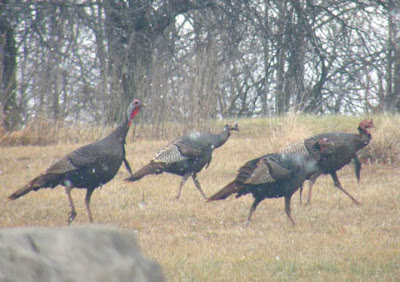
Using the point of a wooden skewer, I mark out the major muscle groups. I will define these areas with a rake tool.

I use a loop tool, called a rake, to go over the clay and make an even surface.

I remove the head of each sculpture, so that I can work on it separately. I have a floor flange, mounted on a board with a section of pipe, which the pipe of the head slips over. I use a laptop (shown) to display pictures of the models, for reference.

I have defined the torso of the man, and begun work on the torso of the woman.

Over the basic figure of the man, I apply clay in the muscle groups of the chest and abdomen.

I have defined the torsos of the man and woman and have added muscle mass to the man's legs.

I feed birds everyday. At the studio, I have 8 places where I put out sunflower seeds. These turkeys are the biggest birds coming in for snacks. It has just started to snow.

We had a fair amount of snow - 6". Here, a female Cardinal and a Red Belly Woodpecker are helping themselves to some sunflower seeds.

Saturday night, we had a freezing fog. The result is that everything has a coating of ice crystals. This is lower field in front of the house. It has flooded from recent rain.

The freezing fog left a heavy layer of ice crystals on these plants.

This is a closeup of ice crystals.













































